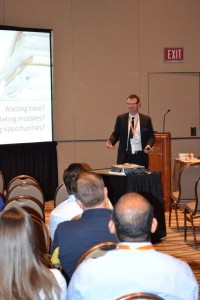I gave a presentation at ICE, the international countertop expo, all about using technology to improve your countertop fabrication business.
Here’s a copy of the slides, but they only tell a small portion of the story. The rest is below…
Slides 1-7. Skip over these, it’s setting the stage for why I’m going to talk about software for countertop fabricators rather than technology in general.
Slide 8. When we’re going through our sales process, there are 3 steps we cover. What you need, what we do, and how to get started.
If you use our software, it’s going to be a great long-term relationship, like a marriage. So, we need to be smart about dating and make sure we’re mutually compatible.
Slide 9. The first step is for us to understand what you need. We rely on having happy customers and the only way people are happy is if they’re getting more value out of our software than they pay for.
Slide 10. When we first started selling our software, people would call up and ask for a demo, and we’d oblige. Believe me, I can demo our software all day long without taking a breath. But, it turned out that we had no idea if what we were showing was relevant.
Now, when we schedule demos with you, it’s really a trick – we want to have a conversation instead. And what’s really important are your answers to these 4 questions:
What are you doing today?
What works?
What doesn’t?
What’s the consequence of not changing?
The more specific we can get, the better idea we’ll have of how much we can help your business.
Slide 11. Skip it. I got audience participation in the seminar by asking questions, and giving away copies of Aaron Crowley’s book – Less Chaos, More Cash.
Slide 12. Typically, the problems in your shop boil down to 3 things.
- Wasting time –like searching for paperwork when a customer calls to find out what’s going on with their job.
- Making mistakes – like showing up at a house at the wrong time, or worse fabricating a countertop out of the wrong granite or with the wrong edge profile.
- Missing opportunities – what’s the cost of not following up with your sales leads?
Slide 13. The most important questions you can ask yourself when you’re looking at software, again. And if you haven’t tried to write down the consequence of not changing, do that – try to put it in terms of money or time.
Slides 14-16. Skip them again. If you want, imagine me telling some awesome jokes.
Slides 17-18. What we’ve discovered is that there are some big red flags when people are investigating our software.
- If you’ve never tried using free software to fix your problems, you’re probably not going to spend money on them.
- If you’re making big changes to the rest of your business, it’s better to wait on implementing job scheduling software.
- If your office manager or production manager don’t agree to use software, it’s better not to buy it.
- And the biggest single factor that determines success is – time. Uninterrupted time to think about the business and how you can apply software to make it better.
Slides 19-20. Skip these, too. It was fun to do the “quizzes”, and I think it forced everyone in the audience to pay attention, too.
Slide 21. The hidden cost of buying our software is your time. Because we feel so strongly about getting started on the right foot, we schedule 5 ½ hour calls with you for the first week. Our goal is that by the last call, you’re up & running on our scheduling, and pretty close to throwing away your whiteboard, spreadsheets, and some of your job folders.
…and that’s it. It was really fun to give the presentation, and I’m hoping that I get a chance to do it again at future stone industry events.
Want to know more? At Moraware, we make software for countertop fabricators. JobTracker is scheduling software that helps you eliminate the time you waste looking for job folders. RemnantSwap is a free place to buy and sell granite remnants with fabricators near you.

